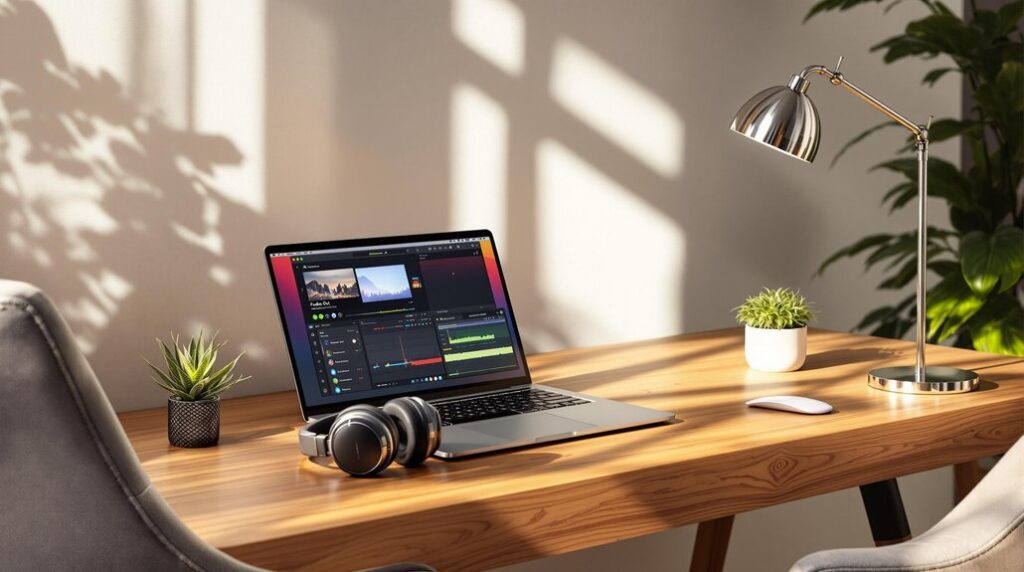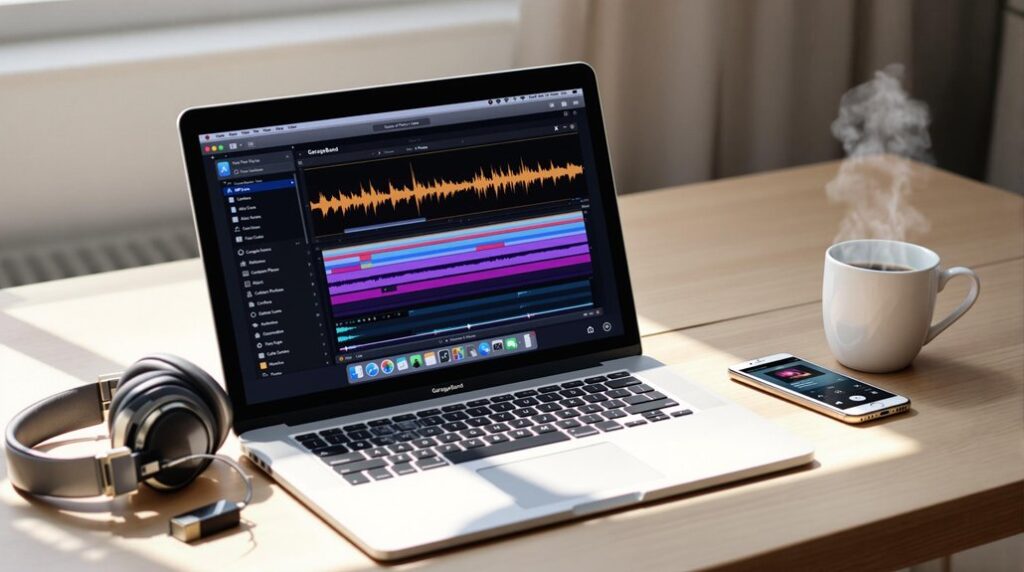To create rap beats in GarageBand, start by establishing a beat foundation. Set the project tempo to 80 BPM and choose a synth bass sound, applying compression for consistent volume. Layer the arrangement with an electronic drum kit, ensuring that the kick and snare are compressed and carry a minimal but loopable pattern. Finally, enhance the composition with melodic elements, like a classic keyboard for chord progressions and a subdued flute sound to add texture, utilizing effects such as echo and reverb. Explore Legacy instruments for unique character. These steps offer a foundation for sophisticated beat production.
Key Takeaways
- Set the project tempo to match your desired rap beat style, typically between 70-100 BPM.
- Choose a strong, rhythmic bassline using synth bass sounds, and apply compression for consistency.
- Select an electronic drum kit, create minimalist patterns, and use compression for the kick and snare.
- Incorporate melodic elements like keyboard or synths, and use effects like reverb for atmosphere.
- Balance all elements with EQ and panning, ensuring clarity and avoiding frequency clashes.
Establishing the Beat Foundation
In the initial stages of crafting rap beats on GarageBand, establishing the beat foundation is vital for creating a cohesive and compelling track.
Begin by setting the project tempo to 80 BPM and dividing the track into 8 sections, which facilitates a structured beat layout. Selecting a synth bass sound is fundamental; maintain the volume slightly below the middle to form a solid foundation without overshadowing other elements.
Implement a compressor on the bass to guarantee consistent volume and a subtle boost in bass frequencies, achieving a fuller sound. Extend bass notes to 5 bars, starting on A and C1, to establish a rhythmic groove that aptly supports rap elements.
Use the metronome feature to maintain timing during the composition process, ensuring each element aligns perfectly within the beat structure. This method introduces a new one, enhancing dynamic interplay within the composition.
Layering Drums and Percussion
Crafting an engaging rap beat requires meticulous attention to the drums and percussion, each element contributing to the track's dynamic character.
Begin by selecting a suitable electronic drum kit in GarageBand, ensuring its volume is slightly raised to establish a robust foundation. Apply compression to the kick and snare to maintain even volume, enhancing punchiness while reducing treble for warmth.
Implement minimalist drum patterns clipped from 1 to 5 bars, creating a clean, loopable rhythm. Hi-hats should be half the size of other elements, with patterns marked and copied for consistency. Introduce open hi-hats at strategic junctures for a little bit of additional texture.
Finally, layer additional percussive sounds like electronic trap drums, adjusting volume and treble for a balanced mix. Consider utilizing transition fills to enhance song dynamics and serve as connectors between sections, maintaining listener engagement and flow.
Enhancing With Melodic Elements
Melodic elements are the soul of a rap beat, offering emotional depth and musical complexity that engage listeners. To harness melodic dynamics, start with a classic keyboard sound, setting the volume to one-third and removing treble for a softer tone.
Create chord progressions beginning on C3 over 1 to 5 bars, then duplicate and adjust for melodic variation. Integrate a flute sound with reduced volume and treble to guarantee a smooth texture.
Enhance the keyboard's atmospheric quality using echo and reverb effects. Consider incorporating synth classics and electric marimba for melodic lines, carefully setting octaves for seamless integration.
Explore the Legacy instruments and vintage synthesizers from GarageBand's Library to add nostalgic elements and unique character to your rap beats. These techniques collectively enrich your rap beats, adding layers of harmonic sophistication while maintaining rhythmic integrity.
Frequently Asked Questions
How Do You Make a Rap Beat Step by Step?
Creating a rap beat involves establishing a clear beat structure, utilizing a balanced tempo, and layering elements such as synth bass, electronic drums, and melodic components. Incorporate effects and adjust octaves for harmonious integration and complexity.
Is Garageband Good for Rap Beats?
GarageBand is highly suitable for producing rap beats, offering excellent beat quality through its intuitive interface, customizable drum kits, and synth sounds. Its advanced MIDI editing and audio effects further enhance the dynamic and polished sound essential in rap music production.
What Program Do Rappers Use to Make Beats?
Rappers frequently utilize digital audio workstations (DAWs) like Ableton Live, FL Studio, and Logic Pro X for beat production. These platforms provide advanced features, intuitive interfaces, and extensive sound libraries essential for creative beat-making and audio engineering.
How Do You Start Rapping on Beats?
To start rapping on beats, engage in lyric writing by aligning your words with the beat's structure. Focus on syllable patterns and rhyme schemes. Experiment with vocal delivery, ensuring your timing and flow harmonize with the instrumental.
Conclusion
To summarize, crafting rap beats in GarageBand necessitates a systematic approach that incorporates foundational beat establishment, precise layering of drums and percussion, and the integration of melodic elements. Utilizing industry-standard techniques and tools provided within the software, producers can create complex and dynamic beats. Through understanding and applying the principles of rhythm, texture, and harmony, one can effectively produce engaging and professional-quality rap beats, enhancing the overall sonic environment and contributing to the evolution of the genre.




